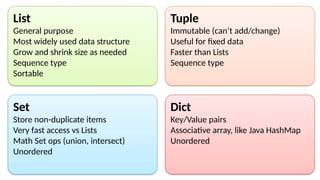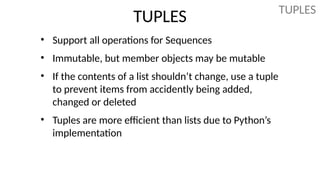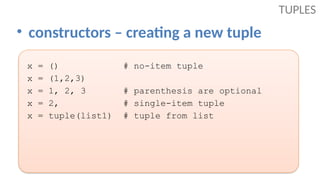Intro Python Data Structures.pptx Intro Python Data Structures.pptx
- 1. Lists, Tuples, Sets, Dicts 5/23/2015
- 2. List General purpose Most widely used data structure Grow and shrink size as needed Sequence type Sortable Tuple Immutable (can’t add/change) Useful for fixed data Faster than Lists Sequence type Set Store non-duplicate items Very fast access vs Lists Math Set ops (union, intersect) Unordered Dict Key/Value pairs Associative array, like Java HashMap Unordered
- 3. SEQUENCES (String, List, Tuple) • indexing: x[6] • slicing: x[1:4] • adding/concatenating: + • multiplying: * • checking membership: in/not in • iterating for i in x: • len(sequence1) • min(sequence1) • max(sequence1) • sum(sequence1[1:3]]) • sorted(list1) • sequence1.count(item) • sequence1.index(item)
- 4. • indexing – Access any item in the sequence using its index x = 'frog' print (x[3]) # prints 'g' String x = ['pig', 'cow', 'horse'] print (x[1]) # prints 'cow' List SEQUENCES String List Tuple
- 5. • slicing – Slice out substrings, sublists, subtuples using indexes [start : end+1 : step] Code Result Explanation x[1:4] 'omp' Items 1 to 3 x[1:6:2] 'opt' Items 1, 3, 5 x[3:] 'puter' Items 3 to end x[:5] 'compu' Items 0 to 4 x[-1] 'r' Last item x[-3:] 'ter' Last 3 items x[:-2] 'comput' All except last 2 items x = 'computer' SEQUENCES String List Tuple
- 6. • adding / concatenating – Combine 2 sequences of the same type using + x = 'horse' + 'shoe' print (x) # prints 'horseshoe' String x = ['pig', 'cow'] + ['horse'] print (x) # prints ['pig', 'cow', 'horse'] List SEQUENCES String List Tuple
- 7. • multiplying – Multiply a sequence using * x = ‘bug' * 3 print (x) # prints ‘bugbugbug' String x = [8, 5] * 3 print (x) # prints [8, 5, 8, 5, 8, 5] List SEQUENCES String List Tuple
- 8. • checking membership – Test whether an item is in or not in a sequence x = 'bug' print ('u' in x) # prints True String x = ['pig', 'cow', 'horse'] print ('cow' not in x) # prints False List SEQUENCES String List Tuple
- 9. • iterating – Iterate through the items in a sequence x = [7, 8, 3] for item in x: print (item * 2) # prints 14, 16, 6 Item x = [7, 8, 3] for index, item in enumerate(x): print (index, item) # prints 0 7, 1 8, 2 3 Index & Item SEQUENCES String List Tuple
- 10. • number of items – Count the number of items in a sequence x = 'bug' print (len(x)) # prints 3 String x = ['pig', 'cow', 'horse'] print (len(x)) # prints 3 List SEQUENCES String List Tuple
- 11. • minimum – Find the minimum item in a sequence lexicographically – alpha or numeric types, but cannot mix types x = 'bug' print (min(x)) # prints 'b' String x = ['pig', 'cow', 'horse'] print (min(x)) # prints 'cow' List SEQUENCES String List Tuple
- 12. • maximum – Find the maximum item in a sequence – alpha or numeric types, but cannot mix types x = 'bug' print (max(x)) # prints 'u' String x = ['pig', 'cow', 'horse'] print (max(x)) # prints 'pig' List SEQUENCES String List Tuple
- 13. • sum – Find the sum of items in a sequence – entire sequence must be numeric type x = [5, 7, 'bug‘] print (sum(x)) # error! String -> Error x = [2, 5, 8, 12] print (sum(x)) # prints 27 print (sum(x[-2:])) # prints 20 List SEQUENCES String List Tuple
- 14. • sorting – Returns a new list of items in sorted order – Does not change the original list x = 'bug' print (sorted(x))# prints ['b', 'g', 'u'] String x = ['pig', 'cow', 'horse'] print (sorted(x)) # prints ['cow', 'horse', 'pig'] List SEQUENCES String List Tuple
- 15. • count (item) – Returns count of an item x = 'hippo' print (x.count('p')) # prints 2 String x = ['pig', 'cow', 'horse', 'cow'] print (x.count('cow')) # prints 2 List SEQUENCES String List Tuple
- 16. • index (item) – Returns the index of the first occurrence of an item x = 'hippo' print (x.index('p')) # prints 2 String x = ['pig', 'cow', 'horse', 'cow'] print (x.index('cow')) # prints 1 List SEQUENCES String List Tuple
- 17. • unpacking – Unpack the n items of a sequence into n variables x = ['pig', 'cow', 'horse'] a, b, c = x # now a is 'pig' # b is 'cow', # c is 'horse' Note: The number of variables must exactly match the length of the list. SEQUENCES String List Tuple
- 18. LISTS All operations from Sequences, plus: • constructors: • del list1[2] delete item from list1 • list1.append(item) appends an item to list1 • list1.extend(sequence1) appends a sequence to list1 • list1.insert(index, item) inserts item at index • list1.pop() pops last item • list1.remove(item) removes first instance of item • list1.reverse() reverses list order • list1.sort() sorts list in place LISTS
- 19. • constructors – creating a new list LISTS x = list() x = ['a', 25, 'dog', 8.43] x = list(tuple1) List Comprehension: x = [m for m in range(8)] resulting list: [0, 1, 2, 3, 4, 5, 6, 7] x = [z**2 for z in range(10) if z>4] resulting list: [25, 36, 49, 64, 81]
- 20. • delete – Delete a list or an item from a list x = [5, 3, 8, 6] del(x[1]) # [5, 8, 6] del(x) # deletes list x LISTS
- 21. • append – Append an item to a list x = [5, 3, 8, 6] x.append(7) # [5, 3, 8, 6, 7] LISTS
- 22. • extend – Append an sequence to a list x = [5, 3, 8, 6] y = [12, 13] x.extend(y) # [5, 3, 8, 6, 7, 12, 13] LISTS
- 23. • insert – Insert an item at given index x.insert(index, item) x = [5, 3, 8, 6] x.insert(1, 7) # [5, 7, 3, 8, 6] x.insert(1,['a','m']) # [5, ['a', 'm'], 7, 3, 8, 6] LISTS
- 24. • pop – Pops last item off the list, and returns item x = [5, 3, 8, 6] x.pop() # [5, 3, 8] # and returns the 6 print(x.pop()) # prints 8 # x is now [5, 3] LISTS
- 25. • remove – Remove first instance of an item x = [5, 3, 8, 6, 3] x.remove(3) # [5, 8, 6, 3] LISTS
- 26. • reverse – Reverse the order of the list x = [5, 3, 8, 6] x.reverse() # [6, 8, 3, 5] LISTS
- 27. • sort – Sort the list in place x = [5, 3, 8, 6] x.sort() # [3, 5, 6, 8] Note: sorted(x) returns a new sorted list without changing the original list x. x.sort() puts the items of x in sorted order (sorts in place). LISTS
- 28. TUPLES • Support all operations for Sequences • Immutable, but member objects may be mutable • If the contents of a list shouldn’t change, use a tuple to prevent items from accidently being added, changed or deleted • Tuples are more efficient than lists due to Python’s implementation TUPLES
- 29. • constructors – creating a new tuple TUPLES x = () # no-item tuple x = (1,2,3) x = 1, 2, 3 # parenthesis are optional x = 2, # single-item tuple x = tuple(list1) # tuple from list
- 30. • immutable – But member objects may be mutable x = (1, 2, 3) del(x[1]) # error! x[1] = 8 # error! x = ([1,2], 3) # 2-item tuple: list and int del(x[0][1]) # ([1], 3) TUPLES
- 31. • constructors – creating a new set SETS x = {3,5,3,5} # {5, 3} x = set() # empty set x = set(list1) # new set from list # strips duplicates Set Comprehension: x = {3*x for x in range(10) if x>5} resulting set: {18, 21, 24, 27} but in random order
- 32. SETS Description Code Add item to set x x.add(item) Remove item from set x x.remove(item) Get length of set x len(x) Check membership in x item in x item not in x Pop random item from set x x.pop() Delete all items from set x x.clear() • basic set operations
- 33. • standard mathematical set operations SETS Set Function Description Code Intersection AND set1 & set2 Union OR set1 | set2 Symmetric Difference XOR set1 ^ set2 Difference In set1 but not in set2 set1 – set2 Subset set2 contains set1 set1 <= set2 Superset set1 contains set2 set1 >= set2
- 34. • constructors – creating a new dict DICTIONARIES x = {'pork':25.3, 'beef':33.8, 'chicken':22.7} x = dict([('pork', 25.3),('beef', 33.8),('chicken', 22.7)]) x = dict(pork=25.3, beef=33.8, chicken=22.7)
- 35. Description Code Add or change item in dict x x['beef'] = 25.2 Remove item from dict x del x['beef'] Get length of dict x len(x) Check membership in x (only looks in keys, not values) item in x item not in x Delete all items from dict x x.clear() Delete dict x del x • basic dict operations DICTIONARIES
- 36. • accessing keys and values in a dict DICTIONARIES x.keys() # returns list of keys in x x.values() # returns list of values in x x.items() # returns list of key-value tuple pairs in x item in x.values() # tests membership in x: returns boolean
- 37. • iterating a dict DICTIONARIES for key in x: # iterate keys print(key, x[key]) # print all key/value pairs for k, v in x.items(): # iterate key/value pairs print(k, v) # print all key/value pairs Note: Entries in a dict are in random order.


![SEQUENCES (String, List, Tuple)
• indexing: x[6]
• slicing: x[1:4]
• adding/concatenating: +
• multiplying: *
• checking membership: in/not in
• iterating for i in x:
• len(sequence1)
• min(sequence1)
• max(sequence1)
• sum(sequence1[1:3]])
• sorted(list1)
• sequence1.count(item)
• sequence1.index(item)](https://image.slidesharecdn.com/intropythondatastructures-241110171454-6e8e0e09/85/Intro-Python-Data-Structures-pptx-Intro-Python-Data-Structures-pptx-3-320.jpg)
![• indexing
– Access any item in the sequence using its index
x = 'frog'
print (x[3]) # prints 'g'
String
x = ['pig', 'cow', 'horse']
print (x[1]) # prints 'cow'
List
SEQUENCES
String List Tuple](https://image.slidesharecdn.com/intropythondatastructures-241110171454-6e8e0e09/85/Intro-Python-Data-Structures-pptx-Intro-Python-Data-Structures-pptx-4-320.jpg)
![• slicing
– Slice out substrings, sublists, subtuples using indexes
[start : end+1 : step]
Code Result Explanation
x[1:4] 'omp' Items 1 to 3
x[1:6:2] 'opt' Items 1, 3, 5
x[3:] 'puter' Items 3 to end
x[:5] 'compu' Items 0 to 4
x[-1] 'r' Last item
x[-3:] 'ter' Last 3 items
x[:-2] 'comput' All except last 2 items
x = 'computer'
SEQUENCES
String List Tuple](https://image.slidesharecdn.com/intropythondatastructures-241110171454-6e8e0e09/85/Intro-Python-Data-Structures-pptx-Intro-Python-Data-Structures-pptx-5-320.jpg)
![• adding / concatenating
– Combine 2 sequences of the same type using +
x = 'horse' + 'shoe'
print (x) # prints 'horseshoe'
String
x = ['pig', 'cow'] + ['horse']
print (x) # prints ['pig', 'cow', 'horse']
List
SEQUENCES
String List Tuple](https://image.slidesharecdn.com/intropythondatastructures-241110171454-6e8e0e09/85/Intro-Python-Data-Structures-pptx-Intro-Python-Data-Structures-pptx-6-320.jpg)
![• multiplying
– Multiply a sequence using *
x = ‘bug' * 3
print (x) # prints ‘bugbugbug'
String
x = [8, 5] * 3
print (x) # prints [8, 5, 8, 5, 8, 5]
List
SEQUENCES
String List Tuple](https://image.slidesharecdn.com/intropythondatastructures-241110171454-6e8e0e09/85/Intro-Python-Data-Structures-pptx-Intro-Python-Data-Structures-pptx-7-320.jpg)
![• checking membership
– Test whether an item is in or not in a sequence
x = 'bug'
print ('u' in x) # prints True
String
x = ['pig', 'cow', 'horse']
print ('cow' not in x) # prints False
List
SEQUENCES
String List Tuple](https://image.slidesharecdn.com/intropythondatastructures-241110171454-6e8e0e09/85/Intro-Python-Data-Structures-pptx-Intro-Python-Data-Structures-pptx-8-320.jpg)
![• iterating
– Iterate through the items in a sequence
x = [7, 8, 3]
for item in x:
print (item * 2) # prints 14, 16, 6
Item
x = [7, 8, 3]
for index, item in enumerate(x):
print (index, item) # prints 0 7, 1 8, 2 3
Index & Item
SEQUENCES
String List Tuple](https://image.slidesharecdn.com/intropythondatastructures-241110171454-6e8e0e09/85/Intro-Python-Data-Structures-pptx-Intro-Python-Data-Structures-pptx-9-320.jpg)
![• number of items
– Count the number of items in a sequence
x = 'bug'
print (len(x)) # prints 3
String
x = ['pig', 'cow', 'horse']
print (len(x)) # prints 3
List
SEQUENCES
String List Tuple](https://image.slidesharecdn.com/intropythondatastructures-241110171454-6e8e0e09/85/Intro-Python-Data-Structures-pptx-Intro-Python-Data-Structures-pptx-10-320.jpg)
![• minimum
– Find the minimum item in a sequence lexicographically
– alpha or numeric types, but cannot mix types
x = 'bug'
print (min(x)) # prints 'b'
String
x = ['pig', 'cow', 'horse']
print (min(x)) # prints 'cow'
List
SEQUENCES
String List Tuple](https://image.slidesharecdn.com/intropythondatastructures-241110171454-6e8e0e09/85/Intro-Python-Data-Structures-pptx-Intro-Python-Data-Structures-pptx-11-320.jpg)
![• maximum
– Find the maximum item in a sequence
– alpha or numeric types, but cannot mix types
x = 'bug'
print (max(x)) # prints 'u'
String
x = ['pig', 'cow', 'horse']
print (max(x)) # prints 'pig'
List
SEQUENCES
String List Tuple](https://image.slidesharecdn.com/intropythondatastructures-241110171454-6e8e0e09/85/Intro-Python-Data-Structures-pptx-Intro-Python-Data-Structures-pptx-12-320.jpg)
![• sum
– Find the sum of items in a sequence
– entire sequence must be numeric type
x = [5, 7, 'bug‘]
print (sum(x)) # error!
String -> Error
x = [2, 5, 8, 12]
print (sum(x)) # prints 27
print (sum(x[-2:])) # prints 20
List
SEQUENCES
String List Tuple](https://image.slidesharecdn.com/intropythondatastructures-241110171454-6e8e0e09/85/Intro-Python-Data-Structures-pptx-Intro-Python-Data-Structures-pptx-13-320.jpg)
![• sorting
– Returns a new list of items in sorted order
– Does not change the original list
x = 'bug'
print (sorted(x))# prints ['b', 'g', 'u']
String
x = ['pig', 'cow', 'horse']
print (sorted(x)) # prints ['cow', 'horse', 'pig']
List
SEQUENCES
String List Tuple](https://image.slidesharecdn.com/intropythondatastructures-241110171454-6e8e0e09/85/Intro-Python-Data-Structures-pptx-Intro-Python-Data-Structures-pptx-14-320.jpg)
![• count (item)
– Returns count of an item
x = 'hippo'
print (x.count('p')) # prints 2
String
x = ['pig', 'cow', 'horse', 'cow']
print (x.count('cow')) # prints 2
List
SEQUENCES
String List Tuple](https://image.slidesharecdn.com/intropythondatastructures-241110171454-6e8e0e09/85/Intro-Python-Data-Structures-pptx-Intro-Python-Data-Structures-pptx-15-320.jpg)
![• index (item)
– Returns the index of the first occurrence of an item
x = 'hippo'
print (x.index('p')) # prints 2
String
x = ['pig', 'cow', 'horse', 'cow']
print (x.index('cow')) # prints 1
List
SEQUENCES
String List Tuple](https://image.slidesharecdn.com/intropythondatastructures-241110171454-6e8e0e09/85/Intro-Python-Data-Structures-pptx-Intro-Python-Data-Structures-pptx-16-320.jpg)
![• unpacking
– Unpack the n items of a sequence into n variables
x = ['pig', 'cow', 'horse']
a, b, c = x # now a is 'pig'
# b is 'cow',
# c is 'horse'
Note:
The number of variables must exactly match the length of the list.
SEQUENCES
String List Tuple](https://image.slidesharecdn.com/intropythondatastructures-241110171454-6e8e0e09/85/Intro-Python-Data-Structures-pptx-Intro-Python-Data-Structures-pptx-17-320.jpg)
![LISTS
All operations from Sequences, plus:
• constructors:
• del list1[2] delete item from list1
• list1.append(item) appends an item to list1
• list1.extend(sequence1) appends a sequence to list1
• list1.insert(index, item) inserts item at index
• list1.pop() pops last item
• list1.remove(item) removes first instance of
item
• list1.reverse() reverses list order
• list1.sort() sorts list in place
LISTS](https://image.slidesharecdn.com/intropythondatastructures-241110171454-6e8e0e09/85/Intro-Python-Data-Structures-pptx-Intro-Python-Data-Structures-pptx-18-320.jpg)
![• constructors – creating a new list
LISTS
x = list()
x = ['a', 25, 'dog', 8.43]
x = list(tuple1)
List Comprehension:
x = [m for m in range(8)]
resulting list: [0, 1, 2, 3, 4, 5, 6, 7]
x = [z**2 for z in range(10) if z>4]
resulting list: [25, 36, 49, 64, 81]](https://image.slidesharecdn.com/intropythondatastructures-241110171454-6e8e0e09/85/Intro-Python-Data-Structures-pptx-Intro-Python-Data-Structures-pptx-19-320.jpg)
![• delete
– Delete a list or an item from a list
x = [5, 3, 8, 6]
del(x[1]) # [5, 8, 6]
del(x) # deletes list x
LISTS](https://image.slidesharecdn.com/intropythondatastructures-241110171454-6e8e0e09/85/Intro-Python-Data-Structures-pptx-Intro-Python-Data-Structures-pptx-20-320.jpg)
![• append
– Append an item to a list
x = [5, 3, 8, 6]
x.append(7) # [5, 3, 8, 6, 7]
LISTS](https://image.slidesharecdn.com/intropythondatastructures-241110171454-6e8e0e09/85/Intro-Python-Data-Structures-pptx-Intro-Python-Data-Structures-pptx-21-320.jpg)
![• extend
– Append an sequence to a list
x = [5, 3, 8, 6]
y = [12, 13]
x.extend(y) # [5, 3, 8, 6, 7, 12, 13]
LISTS](https://image.slidesharecdn.com/intropythondatastructures-241110171454-6e8e0e09/85/Intro-Python-Data-Structures-pptx-Intro-Python-Data-Structures-pptx-22-320.jpg)
![• insert
– Insert an item at given index x.insert(index, item)
x = [5, 3, 8, 6]
x.insert(1, 7) # [5, 7, 3, 8, 6]
x.insert(1,['a','m']) # [5, ['a', 'm'], 7, 3, 8,
6]
LISTS](https://image.slidesharecdn.com/intropythondatastructures-241110171454-6e8e0e09/85/Intro-Python-Data-Structures-pptx-Intro-Python-Data-Structures-pptx-23-320.jpg)
![• pop
– Pops last item off the list, and returns item
x = [5, 3, 8, 6]
x.pop() # [5, 3, 8]
# and returns the 6
print(x.pop()) # prints 8
# x is now [5, 3]
LISTS](https://image.slidesharecdn.com/intropythondatastructures-241110171454-6e8e0e09/85/Intro-Python-Data-Structures-pptx-Intro-Python-Data-Structures-pptx-24-320.jpg)
![• remove
– Remove first instance of an item
x = [5, 3, 8, 6, 3]
x.remove(3) # [5, 8, 6, 3]
LISTS](https://image.slidesharecdn.com/intropythondatastructures-241110171454-6e8e0e09/85/Intro-Python-Data-Structures-pptx-Intro-Python-Data-Structures-pptx-25-320.jpg)
![• reverse
– Reverse the order of the list
x = [5, 3, 8, 6]
x.reverse() # [6, 8, 3, 5]
LISTS](https://image.slidesharecdn.com/intropythondatastructures-241110171454-6e8e0e09/85/Intro-Python-Data-Structures-pptx-Intro-Python-Data-Structures-pptx-26-320.jpg)
![• sort
– Sort the list in place
x = [5, 3, 8, 6]
x.sort() # [3, 5, 6, 8]
Note:
sorted(x) returns a new sorted list without changing the original list x.
x.sort() puts the items of x in sorted order (sorts in place).
LISTS](https://image.slidesharecdn.com/intropythondatastructures-241110171454-6e8e0e09/85/Intro-Python-Data-Structures-pptx-Intro-Python-Data-Structures-pptx-27-320.jpg)


![• immutable
– But member objects may be mutable
x = (1, 2, 3)
del(x[1]) # error!
x[1] = 8 # error!
x = ([1,2], 3) # 2-item tuple: list and int
del(x[0][1]) # ([1], 3)
TUPLES](https://image.slidesharecdn.com/intropythondatastructures-241110171454-6e8e0e09/85/Intro-Python-Data-Structures-pptx-Intro-Python-Data-Structures-pptx-30-320.jpg)



![• constructors – creating a new dict
DICTIONARIES
x = {'pork':25.3, 'beef':33.8, 'chicken':22.7}
x = dict([('pork', 25.3),('beef', 33.8),('chicken', 22.7)])
x = dict(pork=25.3, beef=33.8, chicken=22.7)](https://image.slidesharecdn.com/intropythondatastructures-241110171454-6e8e0e09/85/Intro-Python-Data-Structures-pptx-Intro-Python-Data-Structures-pptx-34-320.jpg)
![Description Code
Add or change item in dict x x['beef'] = 25.2
Remove item from dict x del x['beef']
Get length of dict x len(x)
Check membership in x
(only looks in keys, not values)
item in x
item not in x
Delete all items from dict x x.clear()
Delete dict x del x
• basic dict operations
DICTIONARIES](https://image.slidesharecdn.com/intropythondatastructures-241110171454-6e8e0e09/85/Intro-Python-Data-Structures-pptx-Intro-Python-Data-Structures-pptx-35-320.jpg)

![• iterating a dict
DICTIONARIES
for key in x: # iterate keys
print(key, x[key]) # print all key/value pairs
for k, v in x.items(): # iterate key/value pairs
print(k, v) # print all key/value pairs
Note:
Entries in a dict are in random order.](https://image.slidesharecdn.com/intropythondatastructures-241110171454-6e8e0e09/85/Intro-Python-Data-Structures-pptx-Intro-Python-Data-Structures-pptx-37-320.jpg)














































